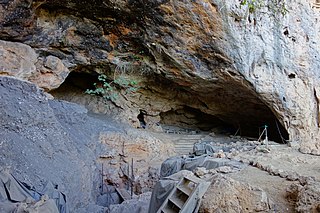Grotto of the Pigeon
| Grotto of the Pigeon
|
||
|---|---|---|
| Location: | Oujda-Angad , Oriental , Morocco | |
|
Geographic location: |
34 ° 48 '53.1 " N , 2 ° 24' 14.3" W | |
|
|
||
| Discovery: | 1908 | |
The Grotte des Pigeons is a cave near Taforalt (hence also Grotte de Taforalt , Arabic مغارة تافوغالت, Called DMG Maġārat Tāfūġālt ) in the Oriental region in eastern Morocco . Since its discovery in 1908, several excavations (1944–1947, 1950–1955 and 1969–1977) have been carried out there, most recently from 2003. The approximately 10 m thick layers that were discovered in the last excavation campaign reached into the Atérien back and contained the remains of more than 180 people of Ibéromaurusien in two burial zones; These and other finds allow far-reaching conclusions to be drawn about changes in diet and burial practice. The latest excavation campaign brought to light finds that were up to 200,000 years old.
Another excavation campaign began in 2003. 13 pierced snail shells ( Nassarius gibbosulus ) were found, which were dated to an age of 82,000 years. Today this species only exists in the eastern Mediterranean; the Palaeolithic representatives were larger and had thicker shells. The shells came from dead animals, were transported 40 km, decorated with ocher and pierced so that they could be worn as a chain. They are considered the oldest symbolic object. In addition, they could be an indication of social exchange networks, since they were moved over considerable distances, similar to objects from a somewhat more recent period.
The latest studies on 52 skeletons from the period between 15,000 and 13,700 before today have shown that the hunters and gatherers were already suffering from tooth decay , although it was mostly assumed that this dental disease only arose with the production of grain. Apparently this had something to do with their diet, which consisted in part of considerable quantities of acorns , but also of pine nuts and pistachios . In addition, it turned out that the residents of the extensive cave not only maintained a cemetery for several millennia, which could indicate a certain type of sedentarism, but also stocked acorns. Since they removed the front teeth for ritual reasons, it is all the more surprising that there was no evidence of the removal of carious teeth.
Land snails must have been added to the diet in large numbers 13,000 years ago . It may have been an abrupt change in a small number of species. These species include Alabastrina alabastrites from the snail family , Helix cf aspersa ( spotted garden snail ), then Dupotetia dupotetiana and Otala punctata from the Otala genus , which also belongs to the snail family, and Cernuella sp from the leaf snail family .
literature
- Abdeljalil Bouzouggar, Nick Barton, Marian Vanhaeren, Francesco d'Errico, Simon Collcutt, Tom Higham , Edward Hodge, Simon Parfitt, Edward Rhodes, Jean-Luc Schwenninger, Chris Stringer, Elaine Turner, Steven Ward, Abdelkrim Moutmir, Abdelhamid Stambouli: 82,000 -year-old shell beads from North Africa and implications for the origins of modern human behavior . Proceedings of the National Academy of Sciences, USA 104 (2007) 1964-1969.
- Louise T. Humphrey, Silvia M. Bello, Elaine Turner, Abdeljalil Bouzouggar, Nick Barton: Iberomaurusian funerary behavior: Evidence from Grotte des Pigeons, Taforalt, Morocco , in: Journal of Human Evolution 62 (2012) 261-273.
- R. Nicholas E. Barton, Abdeljalil Bouzouggar, Simon N. Collcutt, Louise T. Humphrey (Eds.): Cemeteries and Sedentism in the Later Stone Age of NW Africa: Excavations at Grotte des Pigeons, Taforalt, Morocco (monographs of the RGZM, Vol. 147) Propylaeum-eBOOKS 2020
Web links
- Grotto des Pigeons (Morocco) , About.com Archeology
Remarks
- ↑ Louise T. Humphrey, Isabelle De Groote, Jacob Morales, Nick Barton, Simon Collcutt, Christopher Bronk Ramsey, Abdeljalil Bouzouggar: Earliest evidence for caries and exploitation of starchy plant foods in Pleistocene hunter-gatherers from Morocco , PNAS (January 6, 2014 ) doi : 10.1073 / pnas.1318176111 .
- ↑ Victoria Taylor, R. Nicholas E. Barton, Martin Bell, Abdeljalil Bouzouggar, Simon N. Collcutt, S. Black, Joshua T. Hogue: The Epipalaeolithic (Iberomaurusian) at Grotte des Pigeons (Taforalt), Morocco: A preliminary study of the land Mollusca , in: Quaternary International 244.1 (November 2011) 5-14.


